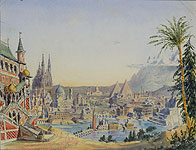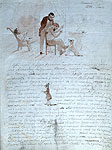European Universities
At last, in the summer of 1840, Nicholas Benois went abroad. His companions in this trip were: the architect Michael Shchurupov and artists: the landscape painter Sokrat Vorobiev, the genre painter Vasily Sternberg and the seascape painter Ivan Aivazovsky.
Drawings of landscapes, of architectural elements and compositions came out from the pen of Nicholas Benois every day of the journey. He studied different architectural styles of European architecture, examining great buildings from the middle ages. The Gothic architecture particularly impressed him, and soon Nicholas Benois became the best Russian expert in the field. His first biographer P. Petrov: & laquo;-, many of the artist's colleagues, indulging the taste of the nobility, launched into designing in the fashion manner, but everything they made was cold and dull. The problem is that the purpose of casual authors was to grasp the main lines, with the poverty of elements in which they even be erred. The in-depth study of Gothic architecture in the place of creation of its greatest examples, in which the Academy's grantee Benois was absorbed, opened to him the secret how to bring the beauty to the simple intersection of curved lines and in the details, unboring for the eyes, even in a long replication. Reaching this state, he worked exquisitely and freely, and the dead Gothic style revived in his elegant and brilliant compositions ... But Benois applied the Gothic style not slavishly, but making good use of others that our time have inherited'.
Numerous sketches and watercolors are contained in N. Benois' albums. Of those, the Department of Manuscripts possesses two large and five small travel albums. In large albums that Nicholas shared among his sons in his will, he pasted his drawings «for the memories». A gallery of colourful sketches, made in Italy, Switzerland, Germany, astonishes us by his sense of beauty, the ability to select the most picturesque objects, landscapes, and views. They characterizes Benois as an outstanding painter of architectural views. All his further works arose from the knowledge and experience gained in Europe, when studying the evolution of architecture over four centuries.
Wonderful sketches depictingthe Villa Farnese at Caprarola, the Monastery of St. Lawrence, near Orvieto, the facade of the Scuola of San Marco in Venice, the Cathedral of St. Rufinus in Assisi, an antique aqueduct near Rome, Cathedrals in Worms, Altenberg, as well as typical Swiss houses — only a small portion of the extant watercolor miniatures. Notworthy among them is the «Architectural Fantasy» in which he combined famous architectural landmarks from various times and different places in one sheet, and matched them with an example of Russian architecture (in the forefront). Alexander Benois' evidence about his father and his friends can explain this drawing, 'they believed in the theory that the medieval architecture of Italy had much in common with the Old Russian architecture, and they also took upon themselves the task of reviving the domestic architecture on their return to Russia'. Nicholas Benois was guided by such considerations when choosing one of the most remarkable Italian Gothic buildings for a close examination. After the second trip throghout northern Italy, he stayed in Orvieto where he, togerther with the grantees A. Rezanov and A. Krakau, spent two years carefully measuring all parts of the main facade of the Cathedral of Our Lady. Benois wrote about it, 'we consider the Cathedral of Orvieto as a perfect example of Christian architecture of the 15th century'. The building was constructed after the design of the architect Lorenzo Maitani. The construction lasted almost three centuries: work at the cathedral was started in 1248 in 1290 and was completed in 1612.The Monograph on the Cathedral of Orvieto, published in Paris in 1877, is an important chapter in the history of study of Western buildings by the Russians. The artists even removed the dirt, dust and grime of centuries from the ancient frescoes and other decorations of the cathedral. Benois wrote in My memories, 'To commemorate this feat, there was issued a medal showing the cathedral on one side and containing an inscription with the names of the three voluntary restorers on the other. In addition, each of them received a huge, luxuriously bound albume of etchings by Italian 18th century artist Giovanni Battista Piranesi from the papal print shop.
During his traveling time, Nicholas parted with his soul mate Vasily Sternberg more than once. These periods are marked by notable letters of the latter,
which remained in the Benois archives: all his life he kept the cherished memory of the untimely deceased friend alive(V. Sternberg died from tuberculosis in Rome in November 1845).A. Benois recalls his father's stories about Alexander Ivanov, the "painfully dull" author of "The Appearance of Christ", 'the appearance of the artist was amazing by its ridiculousness (a pair of dark glasses under a high straw hat, worn clothes without buttons, an eternal umbrella and rubbers). But Ivanov's appearance and all his eccentric manners did not prevent my father, along with his dear friend Vasily Sternberg, from revering piously this ascetic artist as a holy person, and Ivanov, in his turn, made an exception for them and opened to them the door of his usually closed shop many times'.
Before the final departure, Benois came back from Orvieto to Rome where he spent two months, studying the collected materials. Then, having received money for traveling throughout Europe from the Academy, he left Italy and, after a short trip, returned to St. Petersburg on 2 November 1846, six years later.
In Rome, Nicholas Benois had a conversation with Emperor Nicholas I and impressed him by a deep knowledge of classical samples and subsequent architectural styles. So upon arrival to the fatherland, he was immediately taken on the staff of the Cabinet of His Imperial Majesty and, during three years, recieved the salary equal to the grant of a grantee abroad.


